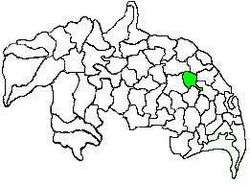Pedakakani mandal
| Pedakakani mandal పెదకాకాని మండలం | |
|---|---|
| Mandal | |
|
Mandal map of Guntur district showing Pedakakani mandal (in green) | |
 Pedakakani mandal Location in Andhra Pradesh, India | |
| Coordinates: 16°20′24″N 80°29′27″E / 16.34000°N 80.49083°ECoordinates: 16°20′24″N 80°29′27″E / 16.34000°N 80.49083°E | |
| Country | India |
| State | Andhra Pradesh |
| District | Guntur |
| Headquarters | Pedakakani |
| Government | |
| • Body | Mandal Parishad |
| • Tehsildar | SK. Ismail |
| Area[1] | |
| • Total | 116.46 km2 (44.97 sq mi) |
| Population (2011)[2] | |
| • Total | 73,689 |
| • Density | 630/km2 (1,600/sq mi) |
| Languages | |
| • Official | Telugu |
| Time zone | IST (UTC+5:30) |
| Vehicle registration | AP |
Pedakakani mandal is one of the 57 mandals in Guntur district of the Indian state of Andhra Pradesh. It is under the administration of Guntur Revenue Division and the headquarters are located at Pedakakani.[3][1] The mandal is bounded by Tadikonda, Mangalagiri, Duggirala, Tenali, Chebrole and Guntur mandals.[4]
Administration
The mandal also forms a part of the Andhra Pradesh Capital Region under the jurisdiction of APCRDA.[5] It is under the control of a tahsildar and the present tahsildar is SK.Ismail.[6] Pedakakani mandal is one of the 3 mandals under Ponnur (Assembly constituency), which in turn represents Guntur (Lok Sabha constituency) of Andhra Pradesh.[7]
Towns and villages
Pedakakani is the most populated village and Devarayabhotlapalem is the least populated settlement in the mandal. As of 2011 census, the mandal has 11 villages.[8]
The settlements in the mandal are listed below:
- Agatha Varappadu
- Anumarlapudi
- Devarayabhotlapalem
- Gollamudi
- Koppuravuru
- Namburu
- Pedakakani
- Takkellapadu
- Tangellamudi
- Uppalapadu
- Venigandla
Education
The mandal plays a major role in education for the rural students of the nearby villages.The primary and secondary school education is imparted by government, aided and private schools, under the School Education Department of the state.[9] As per the school information report for the academic year 2015–16, the mandal has more than 8,943 students enrolled in over 66 schools.[10][11]
See also
References
- 1 2 "District Census Handbook – Guntur" (PDF). Census of India. p. 14,390. Retrieved 22 September 2015.
- ↑ "Census 2011". The Registrar General & Census Commissioner, India. Retrieved 25 August 2014.
- ↑ "Guntur District Mandals" (PDF). Census of India. pp. 84,110. Retrieved 18 January 2015.
- ↑ "Mandals in Guntur district". aponline.gov.in. Retrieved 28 July 2014.
- ↑ "District wise mandals and villages covered in Krishna and Guntur districts" (PDF). Andhra Pradesh Capital Region Development Authority. Government of Andhra Pradesh. Retrieved 23 September 2015.
- ↑ "List of Tahsildars working in Guntur District as on 19.06.2014" (PDF). Guntur District Official Website. National Informatics Centre. p. 1. Retrieved 8 September 2014.
- ↑ "Delimitation of Parliamentary and Assembly Constituencies Order, 2008" (pdf). Election Commission of India. pp. 22,31. Retrieved 11 October 2014.
- ↑ "Sub-District Details of Guntur District". The Registrar General & Census Commissioner, India. Retrieved 18 January 2015.
- ↑ "School Education Department" (PDF). School Education Department, Government of Andhra Pradesh. Retrieved 7 November 2016.
- ↑ "R1.1 SCHOOL INFORMATION".
- ↑ "Student Information Report". Commissionerate of School Education. Child info 2015-16, District School Education - Andhra Pradesh. Retrieved 8 November 2016.

